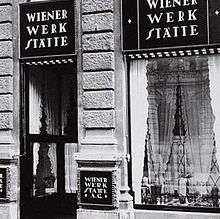Wiener Werkstätte
|
| |
| Public company | |
| Industry | art, interior decoration |
| Founded | 1903–1932 |
| Headquarters | Vienna, Austria |
Key people | Josef Hoffmann, Koloman Moser, Dagobert Peche |
| Products | jewellery, ceramic, furniture, leather, fashion, metalworks |
| Website |
wiener-werkstaette |

.jpg)
Established in 1903, by Koloman Moser and Josef Hoffmann the Wiener Werkstätte (engl.: Vienna's Workshops) was a production community of visual artists in Vienna, Austria bringing together architects, artists and designers, working within the fields of ceramics, fashion, silver, furniture, and the graphic arts.[1]
Origins
The enterprise evolved from the Vienna Secession, founded in 1897 as a progressive alliance of artists and designers. From the start, the Secession had placed special emphasis on the applied arts, and its 1900 exhibition surveying the work of contemporary European design workshops prompted the young architect Josef Hoffmann and his artist friend Koloman Moser to consider establishing a similar enterprise.
Finally in 1903, with backing from the industrialist Fritz Wärndorfer, the Wiener Werkstätte began operations in three small rooms; it soon expanded to fill a three-story building with separate, specially designed facilities for metalwork, leatherwork, bookbinding, woodworking and a paint shop. The range of product lines also included; leather goods, enamel, jewellery, postcards and ceramics. The Wiener Werkstätte even had a millinery department.
Production
Most of the objects produced in the Wiener Werkstatte were stamped with a number of different marks; the trademark of the Wiener Werkstatte, the monogram of the designer and that of the craftsman, who created it. The Wiener Werkstatte had about 100 employees in 1905, of whom 37 were masters of their trade.
The seat of the venture was in Neustiftgasse 32-34, where a new building was adapted to their requirements. Eventually the project exhausted Wärndorfer's fortune. The circle of customers of the Wiener Werkstatte and Josef Hoffmann mainly consisted of artists and Jewish upper middle class supporters of the Austro-Hungarian Empire. Several branches of the workshop were opened in Karlsbad 1909, Marienbad, Zürich 1916/17, New York 1922, Berlin 1929.
In architectural commissions such as the Sanatorium Purkersdorf and the Palais Stoclet in Brussels, the Wiener Werkstätte was able to realize its ideal of the Gesamtkunstwerk (total artwork), a coordinated environment in which everything down to the last detail was consciously designed as an integral part of the whole project.
For several years, beginning in 1904, the Wiener Werkstätte had its own carpentry workshop. Josef Hoffmann designed a furniture line noted for its simple forms for the firm of Jacob & Josef Kohn. But only few pieces of furniture were made there. Most of the furniture known as Wiener Werkstätte Furniture were made by cabinet-makers as: Portois & Fix, Johann Soulek, Anton Herrgesell, Anton Pospisil, Friedrich Otto Schmidt and Johann Niedermoser. Some historians now believe that there are no existing original products of the Wiener Werkstätte Furniture division.
From 1905, the Wiener Werkstatte produced handpainted and printed silks. The Backhausen firm was responsible for the machine-printed and woven textiles. In 1907, the Wiener Werkstätte took over distribution for the Wiener Keramik, a ceramics workshop headed by Michael Powolny and Berthold Löffler. And in the same year Moser, embittered by the financial squabbling, left the Wiener Werkstätte, which subsequently entered a new phase, both stylistically and economically.
Expansion
The founding of textile and fashion divisions in 1909 and 1910 brought a further shift in the Wiener Werkstätte's emphasis—away from the architectural and toward the ephemeral. After a close brush with bankruptcy in 1913, Wärndorfer left to America and the following year Otto Primavesi, a banker from Moravia, took over as chief financier and patron.
During and immediately following the First World War the Wiener Werkstatte was influenced by a new generation of artists and craftsmen. It was Dagobert Peche whose ornamental, almost baroque fancies exerted the most palpable influence. After the war, material shortages encouraged experimentation with less durable, less expensive materials such as wood, ceramics and papier-mâché. One of the ceramics contributors was Walter Bosse.[2] The original, grand Gesamtkunstwerk vision became diluted and submerged by the Kunstgewerbliches—the artsy-craftsy.
At the beginning of the 1920s, Philipp Hausler attempted to eliminate the "bad habits" and "extravagances" which devoured so much money by broadening the workshop's base. The WW artists, however, insisted upon their accustomed exclusivity, and Hausler left in 1925."[3] Attempts to expand the workshop's scope—adding such items as wallpaper to its limited program of industrial licenses, and establishing branches in Berlin, New York and Zurich—were not particularly successful. The Werkstätte's financial situation grew desperate due to the effects of the war and the onset of the world wide Depression in 1929. In the 1932 it was compelled to declare bankruptcy and closed.[3]
A work representative is the Stoclet Palace in Brussels, which is considered a Gesamtkunstwerk of the company.
The chocolate company Altmann & Kühne uses many of the designs of the company for its chocolate boxes, as does Demel.
See also
References
- ↑ "The Vienna Secession: a History". theviennasecession.com. 2 June 2012. Retrieved 29 September 2016.
- ↑ Schreyer-Hartmann, Cherica, and Hans-Hagen and Johanna Hottenroth. Walter Bosse Leben Kunstund Handwerk 1904-1979. Vienna: Verlag Christian Brandstätter, 2000.
- 1 2 Vienna Museum of Applied Arts
- Smetana, Alexandra; Karolyi, Claudia, Austrian Exlibris Society (ÖEG), ed., II The Artist and his Patrons - Josef Hoffmann and the Primavesi Family - The beginnings of the Wiener Werkstätte
External links
| Wikimedia Commons has media related to Wiener Werkstätte. |
- Wiener Werkstaette Archive at MAK
- Wiener Werkstätte (de/en)
- Josef Hoffmann at WOKA (de/en)
- Koloman Moser at WOKA (de/en)
- Sanatorium Purkersdorf at WOKA (de/en)
- Palais Stoclet at WOKA (de/en)
- Arts and Crafts in Vienna 1900
- furniture and lamps designed by Josef Hoffmann for the Wiener Werkstaette
- Wiener Werkstätte Museum
- Austrian Supreme Court Verdict from Oct 15th in German language against the "todays owner of the trademark"
- Wiener Werkstätte postcards and information